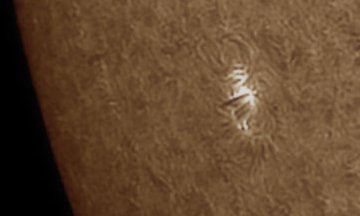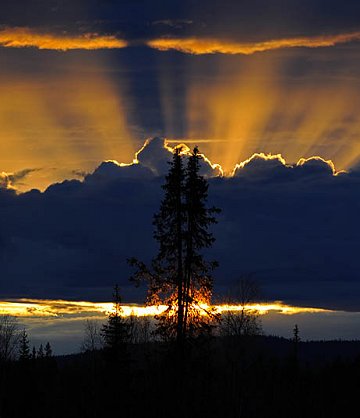| SHUTTLE LANDING POSTPONED: Space shuttle Atlantis will remain in orbit one more day. Mission controllers waved off today's landing attempt because of bad weather at the Kennedy Space Center in Florida. The astronauts will try again on Sunday, May 24th. The first landing opportunity is at 10:11 a.m. EDT. [more] NEW SUNSPOT: Magnetic fields are emerging from beneath the sun's surface to form a new sunspot near the southeastern limb. "It looks a little angry," says Pete Lawrence, who photographed the active region on May 22nd from his backyard observatory in Selsey UK: 
The magnetic polarity of the sunspot identifies it as a member of new Solar Cycle 24, which forecasters expect to peak in May 2013. That makes this little spot a herald of things to come. Readers with solar telescopes, take a look; today you can see sunspot genesis in action. more images: from N. Lavoie and J. Stetson of South Portland, Maine; from Cai-Uso Wohler of Bispingen, Germany; from Didier Favre of Brétigny sur Orge, France; from Christophe Behaegel of Vilvoorde, Belgium; from Keith Davies of Swansea, South Wales, UK; from Günther Strauch of Borken, NRW, Germany; from Mike Borman of Evansville, Indiana; MIDNIGHT SUN: In northern Finland, aurora season is officially over. "We now have sunshine 24 hours a day," reports Sauli Koski of Kittila, Finland, at latitude 68 deg. N. "Here are some rays from last night's midnight sun." 
"The combination of snow clouds and sunbeams made a great display!" he says. "I took the picture using my Nikon D3x." Ten days from now, around June 2nd, a solar wind stream is due to hit Earth. The impact could spark a geomagnetic storm and auroras around the Arctic Circle. If so, no one will see them. With midnight sunbeams like these, it's possible no one will mind. more midnight suns: from Kent Grundstad of Bodoe, Norway
April 2009 Aurora Gallery
[previous Aprils: 2008, 2007, 2006, 2005, 2004, 2003, 2002]
Explore the Sunspot Cycle | 
